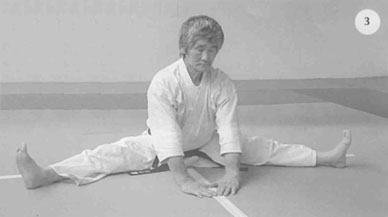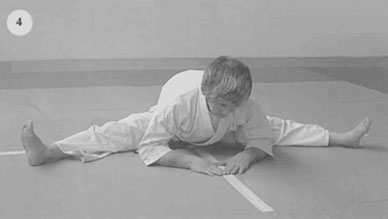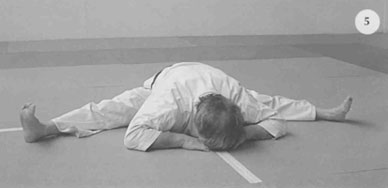// Источник: B.A.F. Newsletter,
Сентябрь 2004, No 48
MAKKO-HŌ
Number 3
|
|
 |
 Photo 1: Begin by opening the legs slowly as tar as is comfortable. Don't strain. With time and regular practice you will be able to open the legs more and more. Push the heels outwards so that the toes are pointing upwards with the big toes turning towards the centre. Put your concentration into you toes. Press the backs of your knees into the tatami and stretch the ligaments in the backs of your knees (the knees must not be bent). Your elbows are relaxed and are brought in towards your sides. Your eyes should be looking forward, your neck straight and stretching upwards. Your back is straight.
Photo 1: Begin by opening the legs slowly as tar as is comfortable. Don't strain. With time and regular practice you will be able to open the legs more and more. Push the heels outwards so that the toes are pointing upwards with the big toes turning towards the centre. Put your concentration into you toes. Press the backs of your knees into the tatami and stretch the ligaments in the backs of your knees (the knees must not be bent). Your elbows are relaxed and are brought in towards your sides. Your eyes should be looking forward, your neck straight and stretching upwards. Your back is straight.
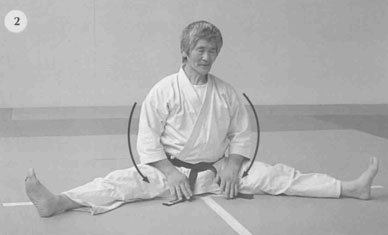 Photo 2: Your hands slide down the tops of your thighs until your fingers touch the tatami. (Imagine water flowing downwards under the force of gravity.)
Photo 2: Your hands slide down the tops of your thighs until your fingers touch the tatami. (Imagine water flowing downwards under the force of gravity.)
Photos 3-5: As you lean forward and incline your upper body your arms are simply hanging. Your palms slide forwards and your elbows bend. The finger tips come together, the thumbs and the index fingers touching to form a triangle. Finally, your elbows come down to touch the tatami and your forehead comes down to make contact with your hands as when making a deep form of za-rei (sitting/kneeling bow). There should be a feeling of expansion in this movement. It should be done slowly without any jerking.
Slowly reverse the movement to come back up to the starting position. This movement should not be done automatically but done with full awareness.
When the body is cold we might stay in the position of Photo 5 for 20 - 40 seconds; and when the body has warmed up we can repeat the bowing movement 10 times (or more if time allows).
This movement is important for developing flexibility in the hips, shoulders and elbows, which is important for Aikido.
Из словаря
| 真 っ 向 法 |
Макко-хо:
|
Макко-хо:
Makko-ho: |
Комплекс из общеукрепляющих упражнений на растяжку.
correct direction method - применение правильного направления
|
|
|

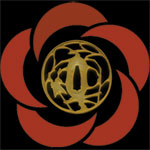

 Photo 1: Begin by opening the legs slowly as tar as is comfortable. Don't strain. With time and regular practice you will be able to open the legs more and more. Push the heels outwards so that the toes are pointing upwards with the big toes turning towards the centre. Put your concentration into you toes. Press the backs of your knees into the tatami and stretch the ligaments in the backs of your knees (the knees must not be bent). Your elbows are relaxed and are brought in towards your sides. Your eyes should be looking forward, your neck straight and stretching upwards. Your back is straight.
Photo 1: Begin by opening the legs slowly as tar as is comfortable. Don't strain. With time and regular practice you will be able to open the legs more and more. Push the heels outwards so that the toes are pointing upwards with the big toes turning towards the centre. Put your concentration into you toes. Press the backs of your knees into the tatami and stretch the ligaments in the backs of your knees (the knees must not be bent). Your elbows are relaxed and are brought in towards your sides. Your eyes should be looking forward, your neck straight and stretching upwards. Your back is straight. Photo 2: Your hands slide down the tops of your thighs until your fingers touch the tatami. (Imagine water flowing downwards under the force of gravity.)
Photo 2: Your hands slide down the tops of your thighs until your fingers touch the tatami. (Imagine water flowing downwards under the force of gravity.)